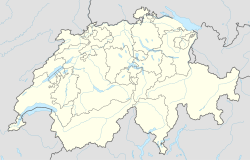Malters
| Malters | ||
|---|---|---|
 |
||
|
||
| Coordinates: 47°2′N 8°11′E / 47.033°N 8.183°ECoordinates: 47°2′N 8°11′E / 47.033°N 8.183°E | ||
| Country | Switzerland | |
| Canton | Lucerne | |
| District | Lucerne | |
| Government | ||
| • Mayor | Ruedi Amrein | |
| Area | ||
| • Total | 28.63 km2 (11.05 sq mi) | |
| Elevation | 512 m (1,680 ft) | |
| Population (Dec 2015) | ||
| • Total | 6,988 | |
| • Density | 240/km2 (630/sq mi) | |
| Postal code | 6102 | |
| SFOS number | 1062 | |
| Surrounded by | Entlebuch, Kriens, Lucerne, Neuenkirch, Ruswil, Schwarzenberg, Werthenstein | |
| Website |
www Profile (German), SFSO statistics |
|
Malters is a municipality in the district of Lucerne in the canton of Lucerne in Switzerland.
Malters is first mentioned in second half of the 9th Century as in Maltrensi marcha. In 1238 it was mentioned as villa Malters.
Malters has an area of 28.6 km2 (11.0 sq mi). Of this area, 64.7% is used for agricultural purposes, while 24.5% is forested. Of the rest of the land, 9.5% is settled (buildings or roads) and the remainder (1.2%) is non-productive (rivers, glaciers or mountains). In the 1997 land survey[update], 24.54% of the total land area was forested. Of the agricultural land, 60.55% is used for farming or pastures, while 4.17% is used for orchards or vine crops. Of the settled areas, 4.73% is covered with buildings, 0.88% is industrial, 0.39% is classed as special developments, 0.25% is parks or greenbelts and 3.29% is transportation infrastructure. Of the unproductive areas, 0.04% is unproductive standing water (ponds or lakes), 1.12% is unproductive flowing water (rivers) and 0.07% is other unproductive land.
The municipality is located about 10 km (6.2 mi) from Lucerne along both sides of the Kleine Emme river. It consists of the village of Malters and, until 1845, the now independent municipality of Schwarzenberg.
Malters has a population (as of 31 December 2015) of 6,988. As of 2007[update], 8.8% of the population was made up of foreign nationals. Over the last 10 years the population has grown at a rate of 3.4%. Most of the population (as of 2000[update]) speaks German (93.2%), with Albanian being second most common ( 2.8%) and Serbo-Croatian being third ( 0.8%).
In the 2007 election the most popular party was the FDP which received 30.9% of the vote. The next three most popular parties were the CVP (27.4%), the SVP (24.3%) and the SPS (8%).
...
Wikipedia




